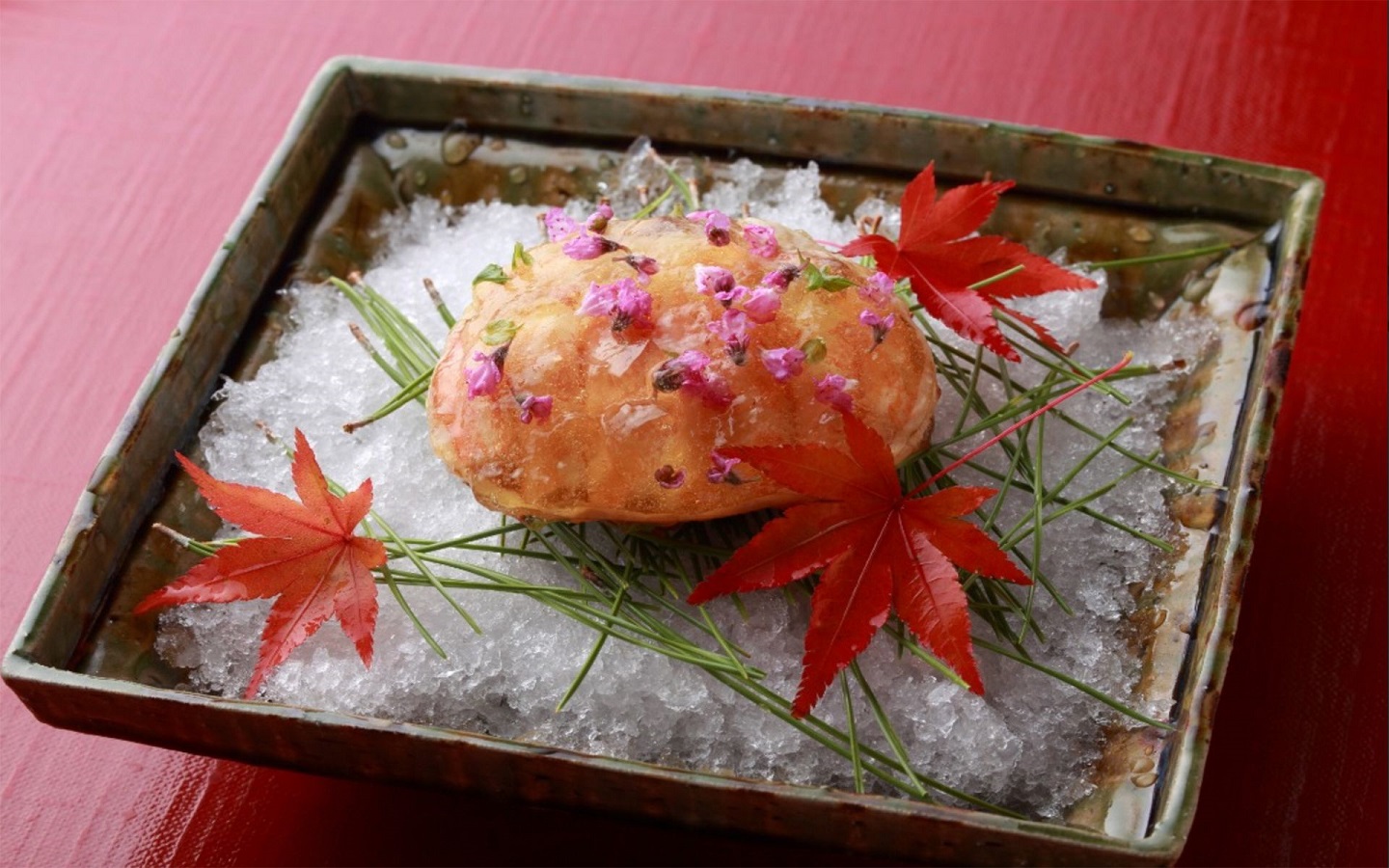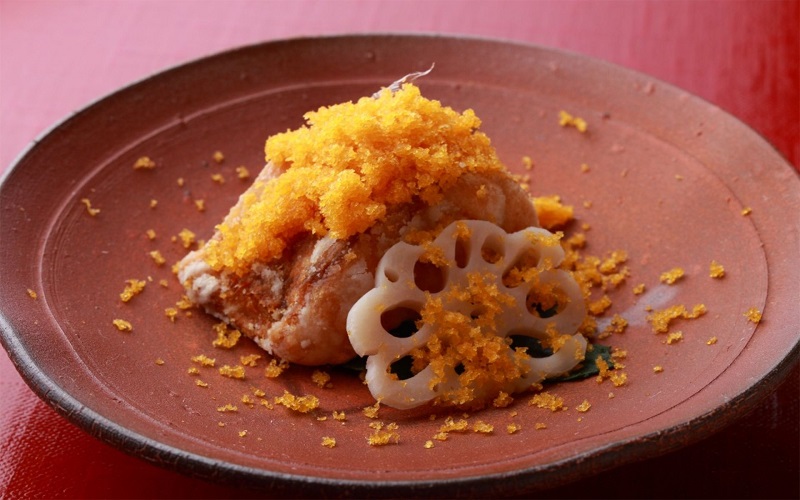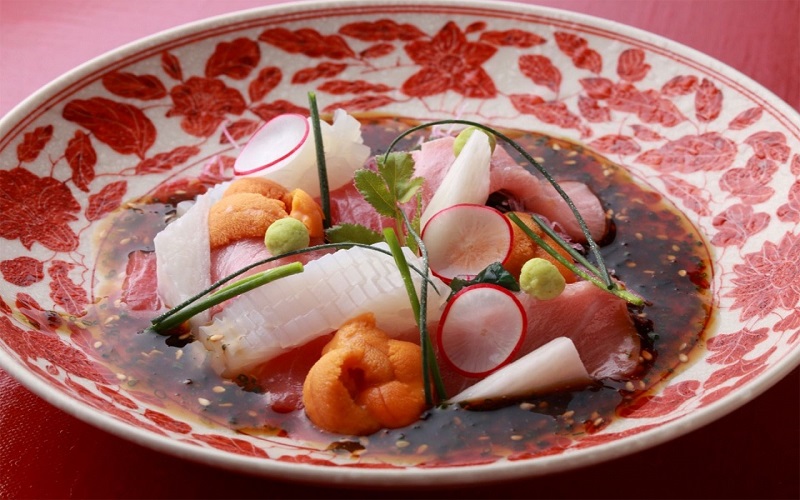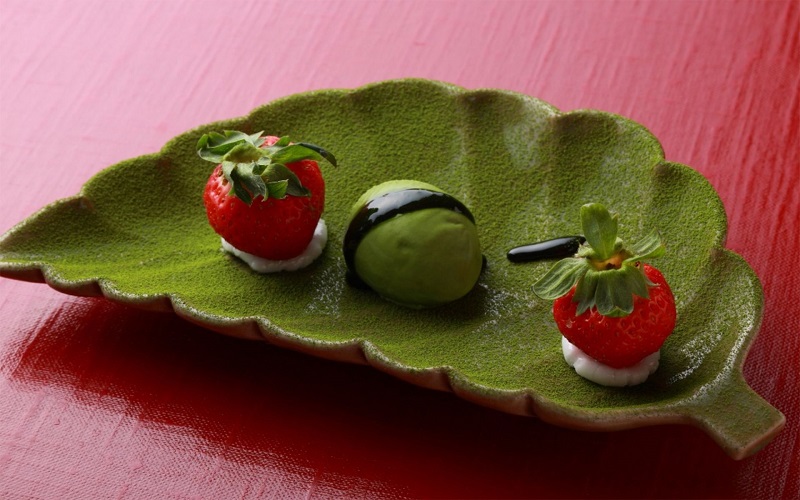
The star ingredient of the night, the gigantic Japanese snow crab from Hyogo prefecture (All photos: Ushi KL/The St Regis Kuala Lumpur)
Takuji Takahashi executes a small bow and takes his place at the centre of the counter. He shares that it’s not a setting he’s used to -—cooking publically in front of his guests — as his one-Michelin star restaurant back home, Kinobu, of Kyoto, comprises mostly of private dining rooms.
Yet, Takahashi, the third-generation owner of what was once a catering restaurant that first opened its doors in 1935, is a man in his element in the kitchen, no matter if it’s in front of an audience or otherwise. Credited with elevating the restaurant with his “new-age Kyoto cuisine”, he has been lauded for marrying new ideas with the traditions of kaiseki-style meals that Kinobu is famous for.
We came to Ushi in The St. Regis Kuala Lumpur on the first of four nights where Chef Takahashi is presenting a specially curated nine course kaiseki dinner. It’s a given that we expected an excellent meal, but we also got a front seat to what feels like a masterclass in the art of Japanese haute cuisine.
“Many people only think of sushi when they think of Japanese food. But that is typically 50 percent fish and the other half is rice. Tonight, we serve you 46 kinds of ingredients. Out of that, half of them are vegetables. That is the essence of Kaiseki, and 80 percent of the meal will consist of water. That is why people say Japanese food is healthy,” he introduces, before quipping, “But water doesn’t mean it’s a cheap meal.”
No stranger to KL, Takahashi shares that Malaysian water is suitable for making his famed dashi soup stock — we’re told it was a key component that elevated Kinobu’s status in the gastronomic world — due to its soft quality with minimal magnesium and calcium content.
st_regis_lotus_root.jpg

But the chef knows these Malaysians are not here to just sample some soup. He brings out the star ingredient of the night, the gigantic Japanese snow crab from Hyogo prefecture. It served its purpose in tantalising us for what is to come.
He then starts on our sakizuke (appetiser), a cold combination of shredded female crab meat and egg, mixed with cucumber and ikura, and topped with a jelly made of bonito and kelp dashi soup. This combination is piled on top of a thin base layer of steamed egg custard.
If a meal offers a narrative, this starter sets the tone for what typically defines kaiseki cuisine — the freshness of ingredients and a balance of flavours. Chef Takahashi’s cooking speaks clearly yet nuancedly of his mastery, as an unexpected sense of lightness and delicate sweetness hits the palate when we take our first bite, enhanced by the drizzle of shiso flowers and a dollop of minced ginger.
He reinforces a similar narrative in the next dish, the tsukuri or sashimi plate. Using tuna first soaked in warm then cold water, along with squid and sea urchin, we get what feels like a garden of harmony, both umami and refreshing. Here, it’s a tale of two sauces, as chef lines the dish with a light ponzu glaze with sesame seeds and finely chopped spring onions, and a thick nori sauce made with kelp and soy sauce.
st_regis_kl.jpg

Recommended to go with the tuna, the seaweed sauce is a show stealer, even as small bites of fresh radish offer a cleansing experience and resets the balance.
When the soup is served, Takahashi forewarns that one may find it too light at first, but promises that at the end, it will be just right. It was also apt a description of our dinner experience. One may be disappointed if one were to expect fancy dishes, as that is not what Kinobu does. What you get though is a sense of simplicity that nevertheless impresses with its intricacy.
Paired with just one prawn paste dumpling and a piece of turnip, the soup forces us to take a pause and seek out the depth of its clean flavours, to gradually discern the surprising hint of smokiness and tinge of fruity aftertaste.
In the humble-looking fried fish, there is no magic to be found, except the mouth-watering fragrance hits our senses the moment the red tilefish chunks were brought out. He shaves mullet fish roe on top as a flavouring agent, while a piece of lotus root pickled in rice vinegar and cut chilli cuts through any greasiness.
By the time our main simmered dish of snow crab is prepared, in the form of individual shells cooked over charcoal like a soup pot, with the same dashi broth mixed with crab meat and roe - this time a male crab along with a delectable taro chunk and chrysanthemum greens with a squeeze of ginger juice — a sense of satiation begins to set in.
dessert.jpg

The final dish of somewhat Western-inspired grilled chicken pre-marinated in soy sauce and mirin paired with a sticky mushroom and scallion rice brings it home as a perfect base note to anchor a thoroughly wholesome meal. After that, the specially made matcha ice cream paired with fresh seasonal strawberries reiterates the concept of balance.
Rather than a particular dish, it was the memory of a collective experience that lingers from chef Takahashi’s dinner. One that — at the risk of being clichéd — makes you thankful for the world’s ingredients and those who have slaved to master the art of making food that honours their existence.
The Kinobu x Ushi Kaiseki dinner menu is served until Sunday, Dec 8, with chef Takahashi and his team cooking two dinners daily, priced at RM1, 200++ per person. Walk-ins are allowed. Call 03 2727 6688 for more information.


